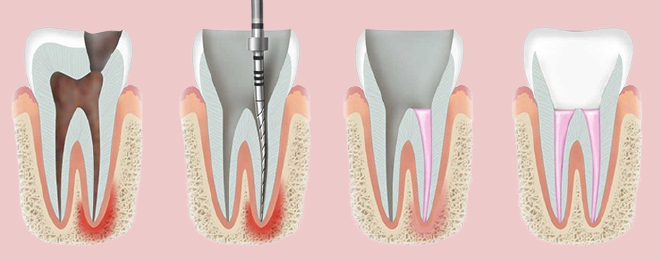
Most of us try to brush and floss regularly to prevent cavities and tooth rot. But even with the best oral care routine, it’s still possible to occasionally get cavities or for bacteria to dig deeper into your teeth and cause an infection.
When this occurs, most dentists will recommend either a root canal or an extraction. Both procedures will prevent a tooth infection from proceeding to other teeth or getting into your jaw. But root canals and extractions are quite different and involve separate procedures.
Today, let’s break down root canals vs. extractions in detail. By the end, you’ll know which of the two you should choose when your dentist gives you the option.
What is an Extraction?
A tooth extraction is a dental procedure that involves removing a tooth completely from its socket. In the majority of cases, extractions are only performed when a tooth is considered unrecoverable, either because of physical damage, rot or decay, or other factors. In other cases, extractions may be performed for orthodontic procedures (i.e. to make room for other teeth in the mouth to result in a straighter smile).
Regardless, tooth extractions are intensive, invasive procedures and require stitches and some amount of aftercare. Compared to a root canal, tooth extractions may be less appealing for those who wish to retain their natural teeth. However, extractions are also usually a little cheaper than root canals.
Extraction Process
A typical tooth extraction process starts when a dentist applies a local anesthetic to numb the affected area. Depending on the location and size of the tooth, a dentist may break the tooth into smaller pieces before pulling the separate pieces out, or they may loosen the tooth with special tools and pull it out in one piece.
If applied properly, the anesthetic should prevent a patient from feeling any pain or discomfort. However, the patient may feel some pressure and may hear cracking and/or popping sounds during the extraction.
Any tooth extraction will lead to some bleeding. A dentist will give a patient gauze to bite down on for around an hour or so. After this point, it’s normal for patients to feel light bleeding or bruising for between 24 to 48 hours after the procedure. Additional symptoms or side effects may include slight bruising or facial swelling, particularly if a back tooth is extracted compared to a front tooth.
Because of the higher potential for pain, dentists usually give prescription pain medications and instructions to take the pain relievers regularly to avoid major discomfort. Over-the-counter pain relievers, such as Advil or Tylenol, are also options.
Most patients feel better between two and three days after a tooth extraction. But it may take up to two weeks for an extraction site to completely heal, which may limit the types of foods and drinks that may be consumed for some time afterward.

Potential Complications of an Extraction
Because a tooth extraction involves completely removing a whole tooth, the procedure is necessarily more invasive. It opens a socket in the mouth, which must be closed by the dentist or surgeon in the same procedure.
Furthermore, a tooth extraction introduces a higher chance for infection compared to a root canal. While sterilized tools are always used, the potential for infection cannot be eliminated 100%.
Additionally, some extracted teeth require replacement after the fact. For example, if the extracted tooth was very important for chewing food, the patient may be required to get a fake tooth fitted and replaced relatively soon after the procedure. This could increase the cost of the overall treatment and the recovery time for the patient.

What is a Root Canal?
A root canal is an advanced dental procedure used to treat infected teeth whose rotten parts cannot be eliminated by a basic filling. As a tooth infection progresses, bacteria chew through the outer enamel layer of the teeth and gradually make their way to the pulp of a tooth (the inner, fleshy layer that determines tooth health).
If an infection progresses far enough, it may also infect a tooth and cause decay. At this point, the tooth is on its way to fully rotting. Either a root canal or extraction is required to prevent the infection from spreading to the jaw, other teeth, or to the bloodstream (which may cause a serious condition called sepsis).
Root canals eliminate the pulp and roots of a tooth, then fill the empty space with a special, antiseptic resin. The tooth is capped with an artificial top to seal the tooth’s interior and prevent future infections from occurring.
Root Canal Process
A root canal process is more technical and advanced but is less invasive than a full tooth extraction.
Like a tooth extraction, a dentist first applies a local anesthetic to numb the affected area throughout the treatment. Depending on the dentist and their tools, they may make a small opening in the tooth to expose the canals. Using technology like 3-D imaging CBCT scans and/or microscopes, the tooth will be imaged and its interior mapped out.
Next, the dentist will use tools to:
- Clean out any decayed material or pulp tissue
- Clean out the tooth roots
- Disinfect the canals with water and antiseptic
Once the tooth has been completely cleared of any infected material or remaining pulp, the dentist fills the tooth canals with a biocompatible material called gutta-percha. This material effectively replaces the tooth pulp and roots but is not as vulnerable to bacterial infections.
Once this is complete, the tooth is sealed and covered with a synthetic crown. The crown is designed to be durable and long-lasting, and it allows the tooth to function like a regular tooth for the rest of the patient’s life in most cases.

Benefits of a Root Canal
Root canal treatments have several major benefits that make them the preferred treatment for patients with a rotten or rotting tooth. These benefits include:
- Reduced potential for future infections. Because a root canal fills an affected tooth with a biocompatible material and seals it away with a crown cap, future infections are much less likely (though not impossible)
- The majority of the tooth is preserved. As a result, the patient can continue to use most of their natural tooth with a minimum of discomfort
- A new tooth is never required
- Recovery time is usually faster, as a socket is not emptied and exposed during the procedure

Are Root Canals Painful?
Although popular belief implies that root canals are very painful, the opposite is true. In fact, root canals are almost never painful at all for patients because local anesthetics are used to numb the affected area throughout the process.
After a root canal, a mild amount of pain or discomfort may be expected. However, your dentist or oral surgeon may provide you with a pain reliever. In many cases, patients can rely on basic over-the-counter pain relievers like Tylenol to handle any pain they may experience.

Choosing Between an Extraction or Root Canal
If your dentist informs you that your tooth needs to be removed or treated with a root canal, you should consider both options carefully. As stated above, extractions are usually a little cheaper, whereas root canals are more expensive because they require more technical procedures and technologies.
That said, most dentists will recommend a root canal if they believe they can save the tooth in question. Root canals are less taxing on your body and introduce fewer physical complications or side effects. Furthermore, a successful root canal means you get to keep your natural tooth, so your smile and bite will be ultimately unaffected by the procedure.
A dentist will not recommend a root canal if the tooth is so far gone that cleaning out the pulp and root would only partially solve the problem. If a tooth is so infected that it can’t be saved, an extraction will be your only option.
Regardless of the procedure you choose, you’ll also need to keep your teeth clean in the future. An electric toothbrush can help ensure that you get rid of plaque and bacteria consistently, mitigating the risk of future infections or tooth decay.

Wrap Up
Both root canals and extractions are valid ways of handling rotting teeth and preserving the oral health of a patient. However, root canals are usually preferred because they allow you to keep your natural tooth for the rest of your life and don’t require as much recovery time as extractions.
It’s up to you to decide between both procedures. No matter which you choose, having the right oral hygiene tools in place will help you ensure that your new tooth or your filled tooth is kept safe and clean for years to come.
That’s why Dr. Brite offers a diverse range of high-quality oral hygiene products, ranging from toothpaste to toothbrushes to mouthwash and more. With the right dental care routine, you might be able to avoid root canals or extractions entirely. Check out our online store today!

